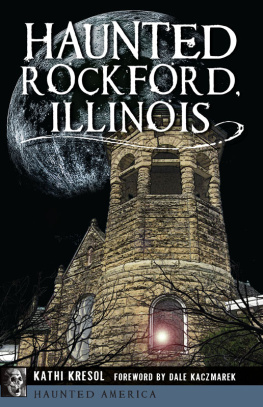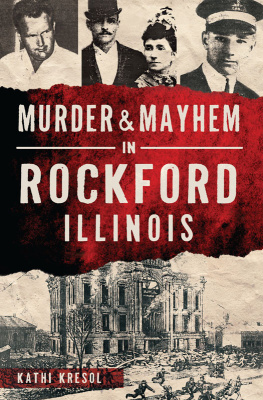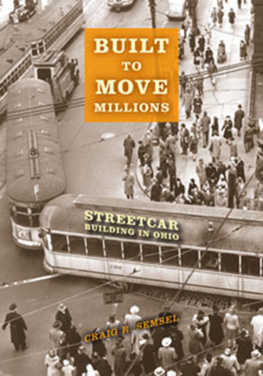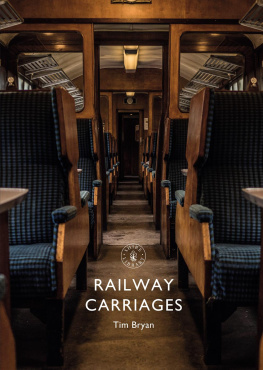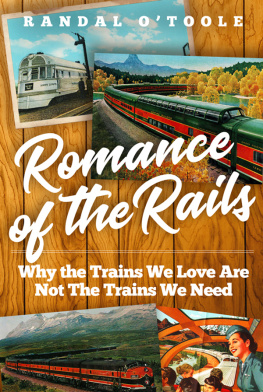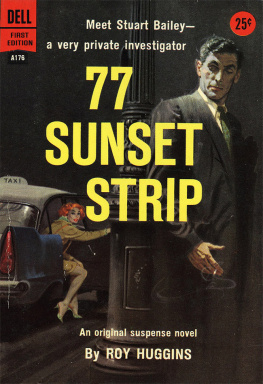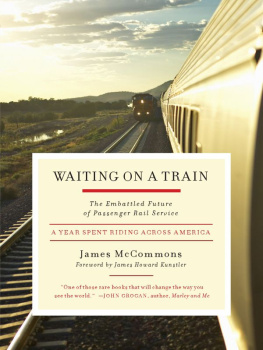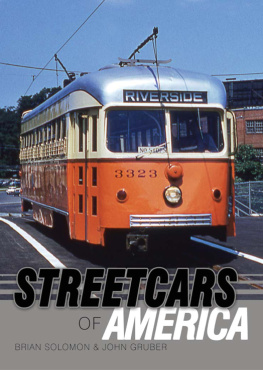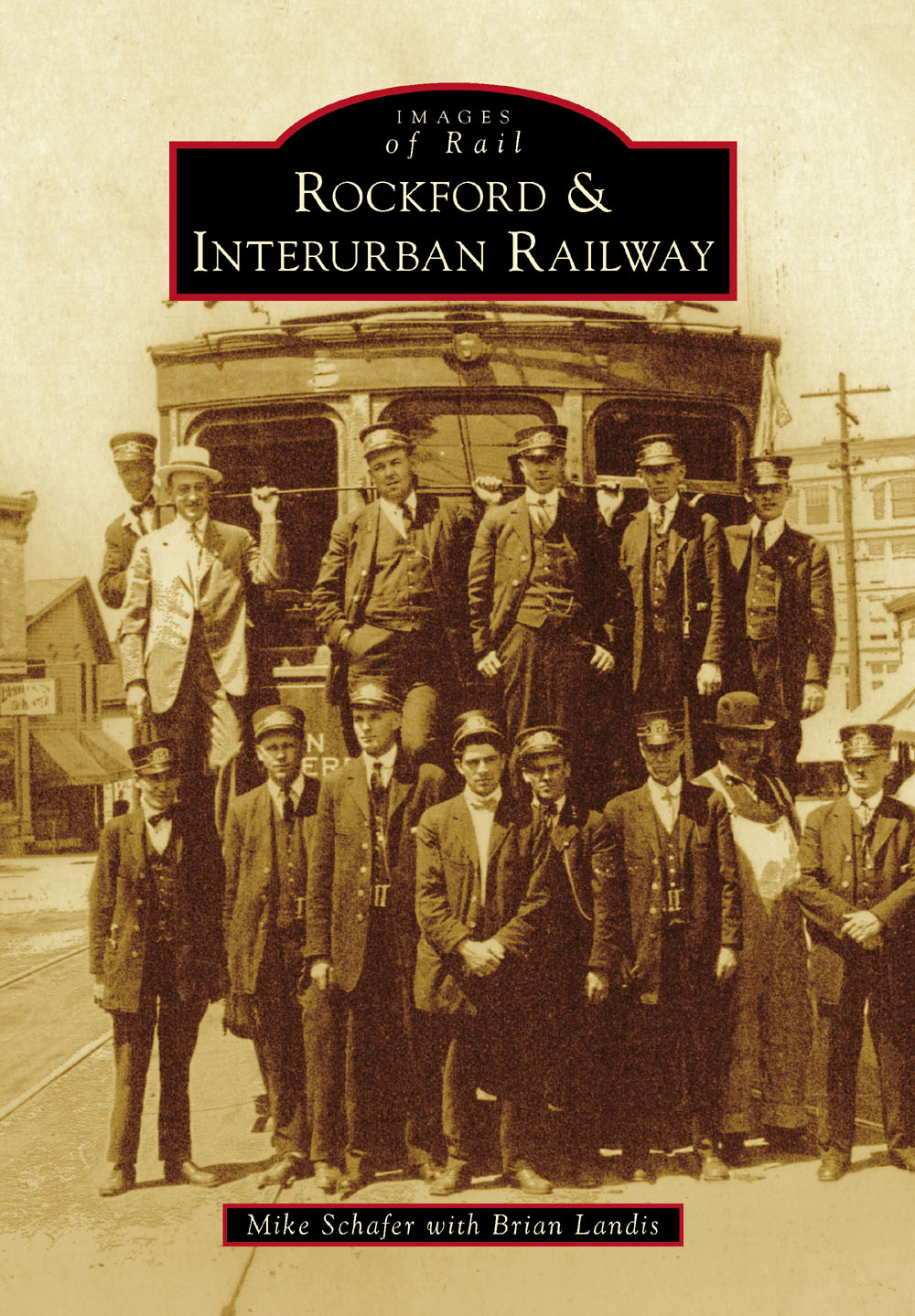
IMAGES
of America
ROCKFORD &
INTERURBAN RAILWAY
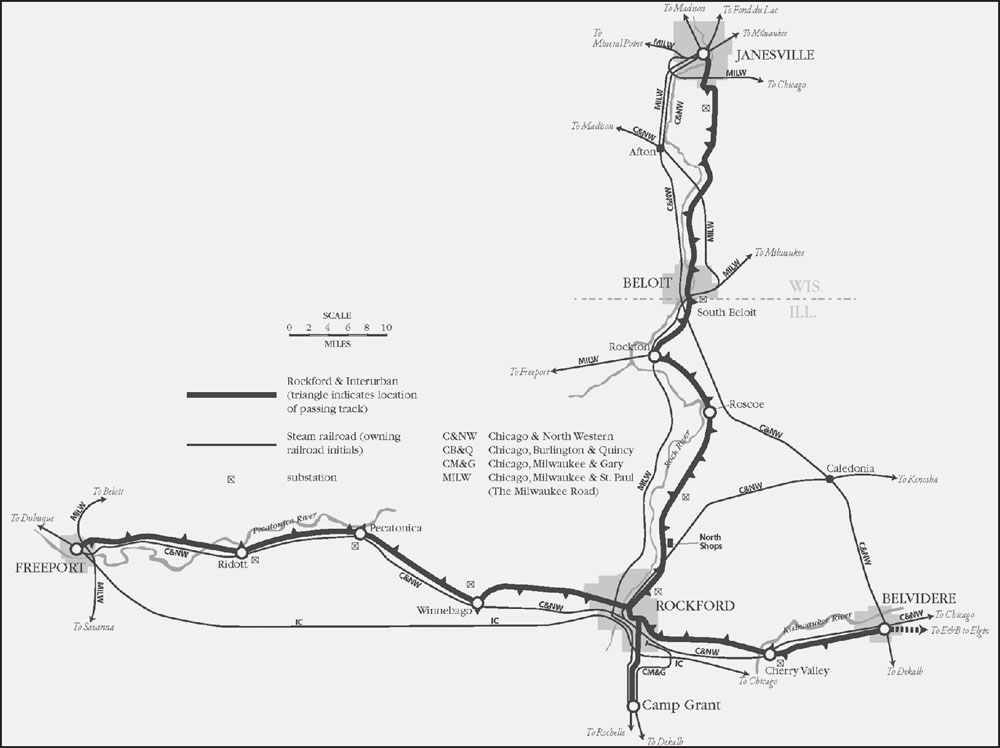
This map of the Rockford & Interurban (heavy line) shows the system at its zenith, around World War I. The principal steam road rail lines of the period are shown as the thinner lines. Not all individual tracks are shown; rather, the map depicts main routes. The steam railroads initials show ownership of those lines during the interurban era. The triangular points on the R&I line indicate the location of passing tracks for trains to get around one another, while the small X boxes indicate substations, which fed boosted electric power to the interurbans overhead wire (catenary) distribution system. (White River Junction Productions: Tom Hooper, Mike Schafer.)
ON THE COVER: Rockford & Interurban employeesmostly conductors, but also a number of company officialspose in front of and on an R&I car parked in the middle of Kishwaukee Street, in front of the carbarn at Rockford. Whether this was a special occasion is unknown, but the photograph was likely taken in the 1920s. The looming facade of the now gone Hess Brothers department store can be seen at right in the distance. The building at left still stands, however. In the late 1960s, it was home to Mid-West Studio, where coauthor Mike Schafer worked as a darkroom technician. (Brian Landis collection.)
IMAGES
of America
ROCKFORD &
INTERURBAN RAILWAY
Mike Schafer with Brian Landis

Copyright 2015 by Mike Schafer with Brian Landis
ISBN 978-1-4671-1239-0
Ebook ISBN 9781439650523
Published by Arcadia Publishing
Charleston, South Carolina
Library of Congress Control Number: 2014952754
For all general information, please contact Arcadia Publishing:
Telephone 843-853-2070
Fax 843-853-0044
E-mail
For customer service and orders:
Toll-Free 1-888-313-2665
Visit us on the Internet at www.arcadiapublishing.com
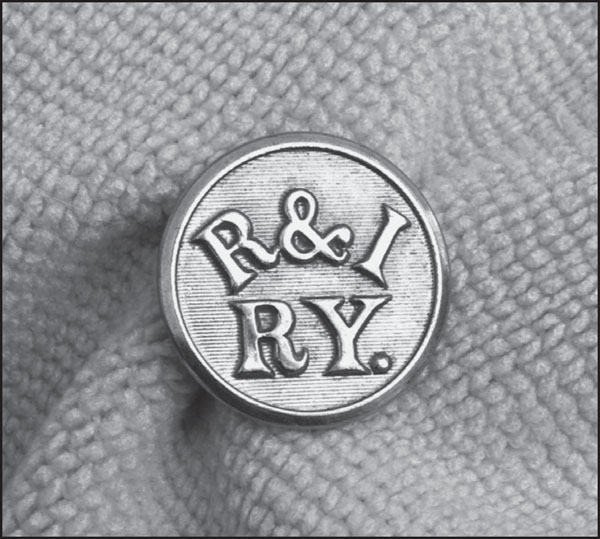
This is a Rockford & Interurban button from a trainmans uniform. (Mike Schafer collection.)
I would like to dedicate this book to my mother, Sandra
Landis, who passed away on May 23, 2014, while I was
working on this book; to grandparents Don and Bessie
Landis, who lived in Rockford, Illinois, near much of the citys
railroad activity; and to Fred and Maxine Germann.
Brian Landis
CONTENTS
ACKNOWLEDGMENTS
Although this book lists two authors, Brian Landis and me, there were many more than two people behind the making of Rockford & Interurban Railway, and we need to shine a spotlight on them. But, I should start with applause for coauthor Brian Landis. Without his fortitude in being able to unearth R&I photographs and other illustrations, this book project would have derailed before we even got out of the station. The bulk of illustrations in this book can be credited to the Brian Landis collection (BLc.). Because of its early demise (1930), the R&I and its affiliate railways were not well documented photographically. But, through Brians relentless searching on the Internet, on eBay, and at local museums and libraries, he located dozens of photographs of the R&I and Rockfords streetcar system, which for a time was operated by the R&I. He was also able to locate photographs of affiliate or subsidiary companies of the R&I. Unfortunately, local newspaper companies were not so accommodating.
For his generous time and very productive efforts, Brian and I must give extra thanks to Norman Carlson, president of the Chicago-based Shore Line Interurban Historical Society (SLIHS); managing editor of the SLIHSs splendid quarterly magazine, First & Fastest; and a board member of Metra, Chicagos commuter-rail system. Without the help of Norm and the SLIHS, there would be some very serious gaps in our coverage.
Also high in the ranks of folks generous with their time and resources in helping with this book is Gordon Geddes, another person well-versed in Midwest interurban history. I met Gordy at the Forest City Model Railroad Club in Rockford when I joined in 1963. Over the yearsaside from being involved in the Rockford Mass Transit DistrictGordy has amassed a large collection of interurban railway photographs, among them several we were able to use in this book. In fact, Gordy flew his photographs down to me from Rockford to Rochelle, Illinois, in his private plane. Thats help and dedication!
In addition, I wish to thank brothers Rory and Cedric Peterson of Belvidere, Illinois, for the use of photographs taken by their father, the late Roy Peterson, another area pioneer railroad photographer. Additional thank-yous for help must go to George Kanary of the Electric Railway Historical Society, and to the folks at Beloit College, Boone County Historical Society, Stephenson County Historical Society, Rock County Historical Society, Rockford Public Library, Rockton Historical Society, Rockford Midway Village, Doug Cohen of Rockford Reminisce (rockfordreminisce.com), Art Peterson of the Krambles-Peterson Archive, Otto M. Vondrak, brothers Scott and Mike Landis, and Donald O. Ellison.
INTRODUCTION
Interurban railway systems played an important, if brief, role in the development of populated areas of the United States. The reign of the interurban as a critical facet of the nations transportation system lasted only about a quarter century, roughly from 1900 to 1925, yet the trains remain a cultural icon of the early 20th century. Interurban railways were the link in the slow transition from the horse-and-buggy era to the automobile age.
To better enjoy and understand the history of the interurban that helped Rockford grow into one of the largest cities in Illinois, we first need to define interurban.
An interurban was a sort of hybrid of a streetcar or trolley (light rail in todays parlance) system and a steam railroad, which was the traditional, full-sized railroad that to this day remains a critical component of North Americas freight and passenger transportation network. Generally, interurbans were designed to link larger cities with their satellite burgs and towns and rural areas. Nearly all interurbans took advantage of the new technology of electric power, specifically the traction motor, which supplied cheap and easy-to-generate electricity. This method powered railcars in a nonpolluting manner while allowing rapid acceleration and deceleration. For this reason, interurbans were often referred to as the traction, and some lines had traction as part of their name, such as the Illinois Traction System. One of Americas most successful interurbans, this lines 550-mile network linked St. Louis, Missouri, with several large central Illinois cities.
Interurbans focused on providing frequent, local service, mostly passenger but also express (package) traffic and a limited amount of freight. The steam railroads concentrated on longer-distance service requiring heavier trains and locomotives. In the early 20th century, the automobile was but a curiosity. Nearly all roads and city streets were of dirt, unpaved and badly rutted, and most people relied on horses and buggies or wagons for transport. So, the coming of the all-weather interurban was hailed as major step in civilizing towns and cities. The onset of the automobile era and publicly funded streets and highwaysnow paved, usually with brick and, later, macadamdoomed the privately owned interurban operations, with the Great Depression of the 1930s providing many nails in the coffins of the weakest interurbans. Today, although electric trolley/streetcar (light rail) systems have regained popularity and success throughout the United Statestheir virtues finally having been rediscoveredonly two true interurbans survivethe South Shore Line between Chicago and South Bend, Indiana, and the Norristown High Speed Line of Philadelphias Southeastern Pennsylvania Transportation Authority. Interestingly, both enjoy higher ridership now than during their reign in the interurbans limelight era. And both remain electric-powered.
Next page

